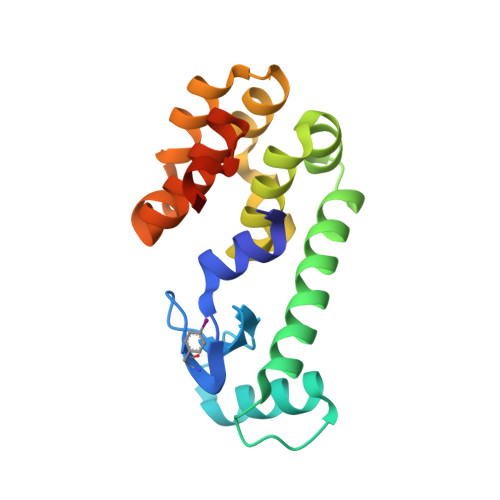Structure-Energy Relationships of Halogen Bonds in Proteins.
Scholfield, M.R., Ford, M.C., Carlsson, A.C., Butta, H., Mehl, R.A., Ho, P.S.(2017) Biochemistry 56: 2794-2802
- PubMed: 28345933
- DOI: https://doi.org/10.1021/acs.biochem.7b00022
- Primary Citation of Related Structures:
5KHZ, 5KI1, 5KI2, 5KI3, 5KI8, 5KIG, 5KII, 5KIM, 5KIO - PubMed Abstract:
The structures and stabilities of proteins are defined by a series of weak noncovalent electrostatic, van der Waals, and hydrogen bond (HB) interactions. In this study, we have designed and engineered halogen bonds (XBs) site-specifically to study their structure-energy relationship in a model protein, T4 lysozyme. The evidence for XBs is the displacement of the aromatic side chain toward an oxygen acceptor, at distances that are equal to or less than the sums of their respective van der Waals radii, when the hydroxyl substituent of the wild-type tyrosine is replaced by a halogen. In addition, thermal melting studies show that the iodine XB rescues the stabilization energy from an otherwise destabilizing substitution (at an equivalent noninteracting site), indicating that the interaction is also present in solution. Quantum chemical calculations show that the XB complements an HB at this site and that solvent structure must also be considered in trying to design molecular interactions such as XBs into biological systems. A bromine substitution also shows displacement of the side chain, but the distances and geometries do not indicate formation of an XB. Thus, we have dissected the contributions from various noncovalent interactions of halogens introduced into proteins, to drive the application of XBs, particularly in biomolecular design.
Organizational Affiliation:
Department of Biochemistry & Molecular Biology, Colorado State University , Fort Collins, Colorado 80523-1870, United States.
















